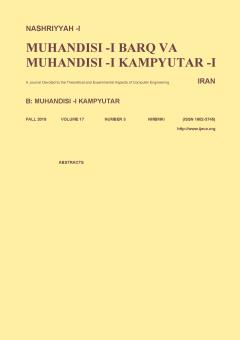Diagnosis of Attention-Deficit/Hyperactivity Disorder (ADHD) based on Variable Length Evolutionary Algorithm
Subject Areas : electrical and computer engineeringM. Ramzanyan 1 , Hussain Montazery Kordy 2 *
1 -
2 - Babol Noshirvani University of Technology
Keywords: Rest state-functional magnetic resonance imaging, ADHD diseasefeature selectionvariable length evolutionary algorithmMahalonobis distanceclassification,
Abstract :
The methods used today to investigate brain connections to diagnose brain-related diseases are the imaging method of resting magnetic resonance imaging. In this paper, a new method is proposed using an evolutionary variable-length algorithm to select the appropriate features to improve the accuracy of the diagnosis of healthy and patient-to-patients with attention deficit hyperactivity disorder based on analysis of rs-fMRI images. The characteristics examined are the correlation values between the time series signals of different regions of the brain. Selection of the variable-length property were based on the honey bee algorithm in order to overcome the problem of feature selection in algorithms with fixed-length vector lengths. The Mahalanubis distance has been used as a bee algorithm evaluation function. The efficiency of the algorithm was evaluated in terms of the value of the evaluation function in the first degree and the processing time in the second degree. The results obtained from the significantly higher efficiency of the variable-length bee algorithm than other methods for selecting the feature. While the best result of the overall categorization accuracy among the other methods with the 26 selected characteristics of the PSO algorithm is 76.61%, the proposed method can achieve a total classification accuracy of 85.32% by selecting 25 features. The nature of the data is such that the increase in the number of attributes leads to a greater improvement in the accuracy of the classification so that by increasing the length of the characteristic vector to 35 and 45, classification accuracy was 91.66% and 95.57% respectively.
[1] T. Banaschewski, et al., "Attention-deficit/hyperactivity disorder," Deutsches Ärzteblatt International, vol. 114, no. 9, pp. 149-159, 3 Mar. 2017.
[2] -, ADHD in Children, Available at: http://www.adhd.com/index.html
[3] م. یوسفی، ع. ا. ابراهیمزاده، ع. خزائی و ع. باباجانی، "آنالیز دادههای fMRI حالت استراحت با استفاده از الگوریتم PSO به منظور تشخیص ADHD،" مجله علمی- پژوهشی رایانش نرم و فناوری اطلاعات، جلد 1، شماره 3، صص. 53-66، پاییز 1391.
[4] S. Clare, Functional Magnetic Resonance Image: Methods and Applications, PhD Thesis, University of Nottingham, England, 1997.
[5] C. Z. Zhu, et al., "Fisher discriminative analysis of resting-state brain function for attention-deficit/hyperactivity disorder," Neuroimage, vol. 40, no. 1, pp. 110-120, 1 Mar. 2008.
[6] W. Cheng, X. Ji, J. Zhang, and J. Feng, "Individual classification of ADHD patients by integrating multiscale neuroimaging markers and advanced pattern recognition techniques," Frontiers in Systems Neuroscience., vol. 6, Article 58, 6 Aug. 2012.
[7] D. Tomasi and N. D. Volkow, "Abnormal functional connectivity in childeren with attention-deficit/hyperactivity disorder," Biological Psychiatry, vol. 71, no. 5, pp. 443-450, 1 Mar. 2012.
[8] A. Eloyan, et al., "Automated diagnoses of attention-deficit/hyperactivity disorder using magnetic resonance imaging," Frontiers in Systems Neuroscience., vol. 6, Article 61, 30 Aug. 2012.
[9] D. Dai, J. Hua, and H. He, "Classification of ADHD children through multimodal magnetic resonance imaging," Frontiers in Systems Neuroscience., vol. 6, Article 63, 3 Sept. 2012.
[10] Q. Cao, Y. Zang, L. Sun, M. Sui, X. Long, Q. Zou, and Y. Wang, "Abnormal neural activity in children with Attention-Deficit Hyperactivity Disorder: a resting-state functional magnetic resonance imaging study," Neuroreport, vol. 17, no. 10, pp. 1033-1036, 17 Jul. 2006.
[11] M. P. Millan, D. Fair, M. Mennes, and S. H. Mostofsky, "The ADHD-200 Consortium: a model to advance the translational potential of neuroimaging in clinical neuroscience," Frontiers in System Neuroscience, vol. 6, Article 62, 6 Sept. 2012.
[12] N. Tzourlo-Mazoyer, et al., "Automated anatomical labeling of activations in SPM using a macroscopic anatomical parcellation of the MNI MRI single-subject brain," Neuroimage, vol. 15, no. 1, pp. 273-289, Jan. 2002.
[13] W. Cheng, X. Ji, J. Zhang, and J. Feng, "Individual classification of ADHD patients by integrating multiscale neuroimaging markers and advanced pattern recognition techniques," Frontiers in System Neuroimaging, vol. 6, Article 58, 6 Aug. 2012.
[14] NITRC, Neuro Bureau: Athena Pipeline, Available at http://www.nitrc.org/plugins/mwiki/index.php/neurobureau: AthenaPipeline #Regional_Homogeniety. 28ReHo.29
[15] I. Guyon and A. Elisseeff, "An introduction to variable and feature selection," J. of Machine Learning Research, vol. 3, no. 1, pp. 1157-1182, 3 Mar. 2003.
[16] S. Theodoridis, A. Pikrakis, K. Koutroumbas, and D. Cavouras, Introduction to Pattern Recognition: A MATLAB Approach, Academic Press, 2010.
[17] D. Karaboga and B. Akay, "A comparative study of Artificial Bee Colony algorithm," Applied Mathematics and Computation, vol. 214, no. 1, pp. 108-132, 1 Aug. 2009.
[18] J. Huang, Y. Cai, and X. Xu, "A hybrid genetic algorithm for feature selection wrapper based on mutual information," Pattern Recognition Letters, vol. 28, no. 13, pp. 1825-1844, 1 Oct. 2007.
[19] J. Kennedy and R. Eberhart, "Particle swarm optimization," in Proc. IEEE Int. Conf. on Neural Networks,, vol. 4, pp. 1942-1948, Perth, Australia, 27 Nov.- 1 Dec. 1995.
[20] B. O. Alijla, L. C. Peng, A. T. Khader, and M. A. Al-Betar, "Intelligent water drops algorithm for rough set feature selection," in the Proc. of the 5th Asian Conf. on Intelligent Information and Database Systems, pp. 356-36, Kuala Lumpur, Malaysia, 18-20 Mar. 2013.

